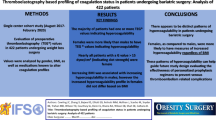Abstract
Background
The objective of this study was to evaluate the coagulation profile by thromboelastography in morbidly obese patients who undergo bariatric surgery. Morbid obesity entails increased risk for thromboembolic events. There is no clear protocol for thromboembolic prophylaxis, regarding timing and length of treatment, in bariatric surgery. Thromboelastography provides data on a coagulation process from creation of the clot until the fibrinolysis.
Methods
Ninety-three morbidly obese patients were prospectively recruited within a 2-year period. Coagulation profile was measured by thromboelastography before surgery, in the immediate postoperative period, within 3 h from surgery, and in the late postoperative period, within 10–14 days after surgery. Venous thromboembolic prophylaxis was achieved by giving low molecular weight heparin (LMWH), once a day.
Results
Of the eligible patients, 67 underwent sleeve gastrectomy while 23 underwent Roux-en-Y gastric bypass. Normal values of coagulation factor function, clotting time, and fibrin function, as measured by R, K, and α (angle), were demonstrated in addition to higher maximal amplitude (MA) values, reflecting increased function of platelets. The average MA value before the surgery was above normal and continued rising consistently in the immediate postoperative as well as in the early postoperative period.
Conclusions
Morbidly obese patients have a strong tendency toward thrombosis, as demonstrated by pathologically elevated MA values. Altered coagulation profiles were demonstrated 2 weeks postoperatively; thus, prophylaxis that continued at least for 2 weeks after bariatric surgery should be considered. Since LMW heparin is not sufficient alone as thromboembolic prophylaxis, we recommend adding antiplatelet therapy. Further evaluation of appropriate thromboprophylaxis is warranted.




Similar content being viewed by others
References
Rocha AT, de Vasconcellos ÂG, da Luz Neto ER, et al. Risk of venous thromboembolism and efficacy of thromboprophylaxis in hospitalized obese medical patients and in obese patients undergoing bariatric surgery. Obes Surg. 2006;16(12):1645–55.
Sapala JA, Wood MH, Schuhknecht MP, et al. Fatal pulmonary embolism after bariatric operations for morbid obesity: a 24-year retrospective analysis. Obes Surg. 2003;13(6):819–25.
Scholten DJ, Hoedema RM, Scholten SE. A comparison of two different prophylactic dose regimens of low molecular weight heparin in bariatric surgery. Obes Surg 2002; 19–24
Schwenk W, Bohm B, Fugener A, et al. Intermittent pneumatic sequential compression (ISC) of the lower extremities prevents venous stasis during laparoscopic cholecystectomy. A prospective randomized study. Surg Endosc. 1998;12(1):7–11.
Westling A, Bergqvist D, Bostrom A, et al. Incidence of deep venous thrombosis in patients undergoing obesity surgery. World J Surg. 2002;26(4):470–3.
Eriksson S, Backman L, Ljungstrum KG. The incidence of clinical postoperative thrombosis after gastric surgery for obesity during 16 years. Obes Surg. 1997;7(4):332–5.
Pivalizza EG, Pivalizza PJ, Weavind LM. Perioperative thromboelastography and sonoclot analysis in morbidly obese patients. Can J Anaesth. 1997;44(9):942–5.
Whitten CW, Greilich PE. Thromboelastography®: past, present, and future. J Am Soc Anesthesiol. 2000;92(5):1226.
Dai Y, Lee A, Critchley LAH, et al. Does thromboelastography predict postoperative thromboembolic events? A systematic review of the literature. Anesth Analg. 2009;108(3):734–42.
Traverso CI, Arcelus JI, Gomez E, et al. Prospective assessment of the risk of deep vein thrombosis in elective abdominal surgery. Predictive role of thromboelastography. Thromb Haemorrh Disord. 1993;7(1):9–15.
Melinek J, Livingston E, Cortina G, et al. Autopsy findings following gastric bypass surgery for morbid obesity. Arch Pathol Lab Me. 2002;126(9):1091–5.
Hamad GG, Choban PS. Enoxaparin for thromboprophylaxis in morbidly obese patients undergoing bariatric surgery: findings of the prophylaxis against VTE outcomes in bariatric surgery patients receiving enoxaparin (PROBE) study. Obes Surg. 2005;15(10):1368–74.
Rondina MT, Wheeler M, Rodgers GM, et al. Weight-based dosing of enoxaparin for VTE prophylaxis in morbidly obese, medically-ill patients. Thromb Res. 2010;125(3):220–3.
Kaye SM, Pietiläinen KH, Kotronen A, et al. Obesity-related derangements of coagulation and fibrinolysis: a study of obesity-discordant monozygotic twin pairs. Obesity. 2012;20(1):88–94.
Nguyen NT, Owings JT, Gosselin R, et al. Systemic coagulation and fibrinolysis after laparoscopic and open gastric bypass. Arch Surg. 2001;136(8):909–16.
Anfossi G, Russo I, Trovati M. Platelet dysfunction in central obesity. Nutr Metab Cardiovasc Dis. 2009;19(6):440–9.
Lijnen HR. Role of fibrinolysis in obesity and thrombosis. Thromb Res 2009;123(S4)
McCrath DJ, Cerboni E, Frumento RJ, et al. Thromboelastography maximum amplitude predicts postoperative thrombotic complications including myocardial infarction. Anesth Analg. 2005;100(6):1576–83.
Forfori F, Ferro B, Mancini B, et al. Role of thrombolestagrophy in monitoring perioperative coagulation status and effect of thromboprophylaxis in bariatric surgery. Obes Surg. 2012;22(1):113–8.
Wu EC, Barba CA. Current practices in the prophylaxis of venous thromboembolism in bariatric surgery. Obes Surg. 2000;10(1):7–13.
Polanco-García M, Cubas MG, Rivas E, et al. Can preorerative thromboelastography be useful managing pharmacologic thromboembolic prophylaxis in bariatric surgery? Eur J Anaesthesiol. 2012;29:94.
Taura P, Rivas E, Martinez-Palli G, et al. Clinical markers of the hypercoagulable state by rotational thrombelastometry in obese patients submitted to bariatric surgery. Surg Endosc. 2014;28(2):543–51.
Kashuk JL, Moore EE, Sabel A, et al. Rapid thrombelastography (r-TEG) identifies hypercoagulability and predicts thromboembolic events in surgical patients. Surgery. 2009;146(4):764–74.
Gonzalez E, Kashuk JL, Moore EE, et al. Differentiation of enzymatic from platelet hypercoagulability using the novel thrombelastography parameter delta (Δ). J Surg Res. 2010;163(1):96–101.
Pickering E, Menazzi-Moretti A, Ahmed A, et al. Determination of peri-operative hypercoagulability in bariatric surgery using thromboelastography: interim results. Anesthesia. 2011;66:148–9.
Author information
Authors and Affiliations
Corresponding author
Ethics declarations
Conflict of Interest
The authors declare that they have no conflict of interest.
Statement of Informed Consent
Informed consent was obtained from all individual participants included in the study.
Statement of Human and Animal Rights
All procedures performed in studies involving human participants were in accordance with the ethical standards of the institutional and/or national research committee and with the 1964 Helsinki Declaration and its later amendments or comparable ethical standards. No animals were used in this study.
Rights and permissions
About this article
Cite this article
Moaad, F., Zakhar, B., Anton, K. et al. Is LMWH Sufficient for Anticoagulant Prophylaxis in Bariatric Surgery? Prospective Study. OBES SURG 27, 2331–2337 (2017). https://doi.org/10.1007/s11695-017-2638-1
Published:
Issue Date:
DOI: https://doi.org/10.1007/s11695-017-2638-1




